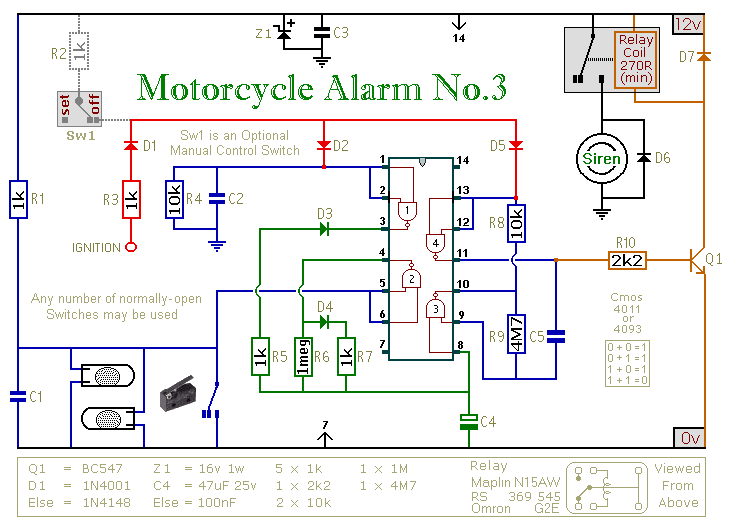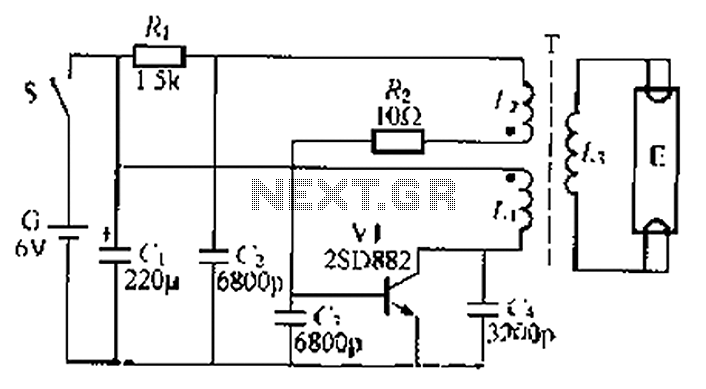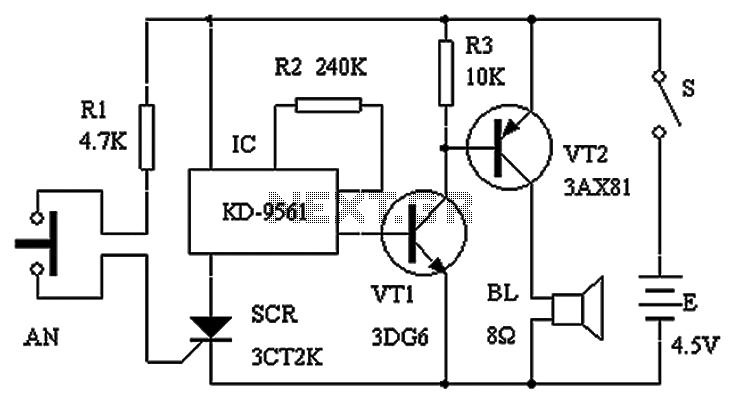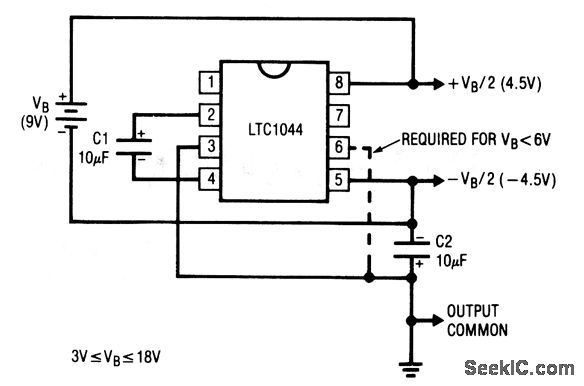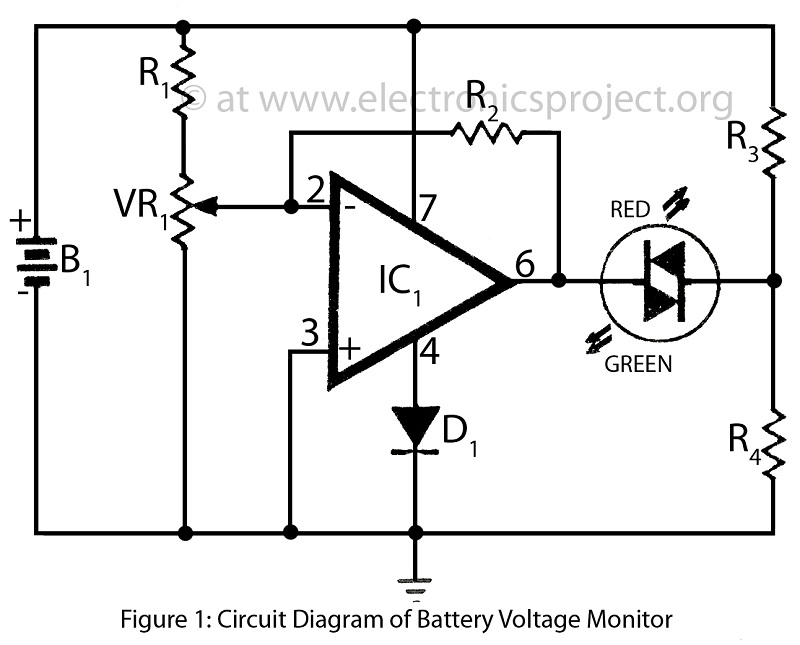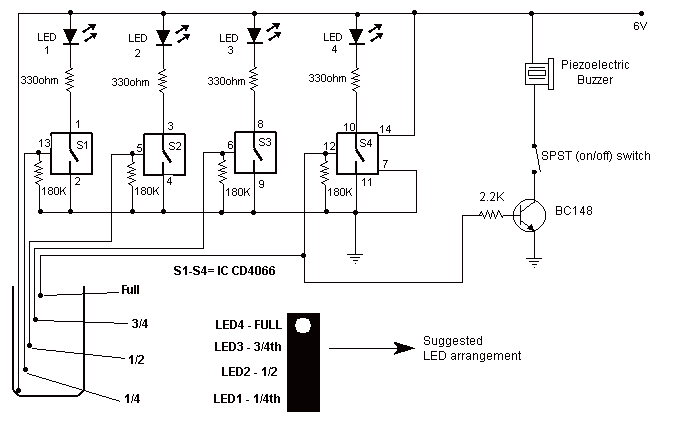
Smoke Alarm Battery Life Extender
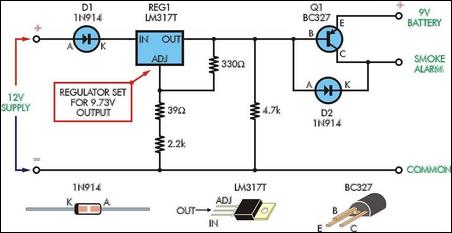
Although smoke alarms are relatively inexpensive devices, the cost of 9V batteries can quickly surpass their initial purchase price. Additionally, the annoyance of intermittent beeping from the alarm as the battery nears the end of its life can be frustrating. This circuit enables standard smoke alarms to be powered from a 12V supply used in burglar alarms while still retaining the standard 9V batteries. It extends the 9V battery life to match its shelf life, as the battery is only needed to power the smoke alarm if the 12V supply is disconnected or fails. Under normal conditions, the LM317 voltage regulator supplies 9.7V, which is directed to the smoke alarm through diode D2, providing just over 9V at the smoke alarm's supply terminals. In this state, Q1 remains off, disconnecting the 9V battery from the circuit. If the 12V supply is lost, the output of the LM317 drops to 0V, turning on Q1 through the 4.7kΩ resistor, allowing the smoke alarm to continue functioning. The circuit can be assembled on a piece of Veroboard and integrated within the smoke alarm or housed alongside the 9V battery in a standard electrical flush-mount box, which is covered by the smoke alarm upon installation.
This circuit design effectively integrates a smoke alarm with a dual power supply system, enhancing reliability and reducing maintenance costs associated with battery replacements. The LM317 voltage regulator is a crucial component, providing a stable output voltage of 9.7V, which is slightly above the nominal voltage required by most smoke alarms. This ensures optimal performance while allowing for a small voltage drop across the diode D2, which rectifies the output to just over 9V.
The transistor Q1 serves as a switch that controls the connection between the 9V battery and the smoke alarm. Under normal operating conditions, when the 12V supply is available, the LM317 keeps the voltage stable, and Q1 remains off, effectively isolating the battery from the circuit. This not only preserves the battery life but also prevents the unwanted beeping associated with low battery voltage.
In the event of a power failure, the LM317's output ceases, causing Q1 to turn on due to the biasing through the 4.7kΩ resistor. This allows the smoke alarm to draw power from the 9V battery, ensuring continued operation during emergencies. The choice of using a Veroboard for assembly offers flexibility in layout and component placement, making it easier to adapt the circuit to fit within the smoke alarm housing.
For installation, it is recommended to securely mount the circuit in a manner that avoids interference with the smoke alarm's operation. The alternative option of using a flush-mount box allows for a more streamlined appearance while providing easy access for battery replacement when necessary. Overall, this circuit design not only enhances the functionality of smoke alarms but also contributes to a safer environment by ensuring uninterrupted operation during power outages.While smoke alarms are quite cheap devices, the cost of 9V batteries quickly exceeds their purchase price. Added to that is the irritation of random beeps from the alarm as the battery reaches the end of its useful life.
This circuit allows typical smoke alarms to be powered from the 12V supply in a burglar alarm while still keeping the standard 9 V batteries in place. It extends the 9V battery life to that of its "shelf life" as the battery is only required to drive the smoke alarm in the event the 12V supply is removed or shorted out. In normal operation, the LM317 supplies 9. 7V and this is fed via diode D2, resulting in just over 9V at the smoke alarm supply terminals. Q1 is not biased on, so the 9V battery is disconnected from the circuit. If the 12V supply is removed, the output of the LM317 will be 0V and Q1 will be biased on via the 4. 7kO resistor and thus the smoke alarm will continue to be powered. The circuit could be assembled on a piece of Veroboard and fitted inside the smoke alarm. Alternatively, you could house the circuit and 9V battery within a standard electrical flush-mount box which the smoke alarm covers when mounted.
🔗 External reference
This circuit design effectively integrates a smoke alarm with a dual power supply system, enhancing reliability and reducing maintenance costs associated with battery replacements. The LM317 voltage regulator is a crucial component, providing a stable output voltage of 9.7V, which is slightly above the nominal voltage required by most smoke alarms. This ensures optimal performance while allowing for a small voltage drop across the diode D2, which rectifies the output to just over 9V.
The transistor Q1 serves as a switch that controls the connection between the 9V battery and the smoke alarm. Under normal operating conditions, when the 12V supply is available, the LM317 keeps the voltage stable, and Q1 remains off, effectively isolating the battery from the circuit. This not only preserves the battery life but also prevents the unwanted beeping associated with low battery voltage.
In the event of a power failure, the LM317's output ceases, causing Q1 to turn on due to the biasing through the 4.7kΩ resistor. This allows the smoke alarm to draw power from the 9V battery, ensuring continued operation during emergencies. The choice of using a Veroboard for assembly offers flexibility in layout and component placement, making it easier to adapt the circuit to fit within the smoke alarm housing.
For installation, it is recommended to securely mount the circuit in a manner that avoids interference with the smoke alarm's operation. The alternative option of using a flush-mount box allows for a more streamlined appearance while providing easy access for battery replacement when necessary. Overall, this circuit design not only enhances the functionality of smoke alarms but also contributes to a safer environment by ensuring uninterrupted operation during power outages.While smoke alarms are quite cheap devices, the cost of 9V batteries quickly exceeds their purchase price. Added to that is the irritation of random beeps from the alarm as the battery reaches the end of its useful life.
This circuit allows typical smoke alarms to be powered from the 12V supply in a burglar alarm while still keeping the standard 9 V batteries in place. It extends the 9V battery life to that of its "shelf life" as the battery is only required to drive the smoke alarm in the event the 12V supply is removed or shorted out. In normal operation, the LM317 supplies 9. 7V and this is fed via diode D2, resulting in just over 9V at the smoke alarm supply terminals. Q1 is not biased on, so the 9V battery is disconnected from the circuit. If the 12V supply is removed, the output of the LM317 will be 0V and Q1 will be biased on via the 4. 7kO resistor and thus the smoke alarm will continue to be powered. The circuit could be assembled on a piece of Veroboard and fitted inside the smoke alarm. Alternatively, you could house the circuit and 9V battery within a standard electrical flush-mount box which the smoke alarm covers when mounted.
🔗 External reference
Warning: include(partials/cookie-banner.php): Failed to open stream: Permission denied in /var/www/html/nextgr/view-circuit.php on line 713
Warning: include(): Failed opening 'partials/cookie-banner.php' for inclusion (include_path='.:/usr/share/php') in /var/www/html/nextgr/view-circuit.php on line 713
